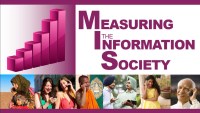The world online: the ITU provides the numbers


About 250 million people came online in 2012, and 2.7 billion people will be connected to the internet by the end of 2013. This is an impressive number, though it also means that 4.4 billion people will not be connected. The numbers come from the International Telecommunication Union (ITU), which has just released its annual report, Measuring the Information Society (PDF). This covers fixed and mobile internet connections, television, and this year, a section on "digital natives": people aged 15-24 with five years experience of information and communications technologies (ICT).
Korea tops the world rankings as the country with the best ICT infrastructure, followed by a clutch of Scandinavian countries: Sweden, Iceland, Denmark, Finland and Norway. This year, the UK jumped three places to 8th, pushing Japan out of the top 10. The USA dropped one place to 17th, just ahead of France, Germany and Canada.
The rankings favour small countries with concentrated populations. As well as those already mentioned, the top 20 includes Luxembourg, Hong Kong, Switzerland, Macao, Singapore and New Zealand. It also benefits countries that have installed lots of fibre, including Korea and Sweden. More than half of Sweden's homes and businesses could get 100Mbps broadband in 2012.
It's much harder to deliver ICT in poor countries with large rural populations, and 90 percent of the not-yet-connected are in the developing world. The worst performers include most central African countries, the Indian subcontinent, and parts of south east Asia. Many of these countries have much worse problems than low Internet penetration. These may include shortages of food and clean water, a lack of health care, poverty, and armed conflict.
The country rankings are based on 11 criteria including the number of fixed and mobile connections per 100 inhabitants, the percentage of households with a computer, international internet bandwidth, the adult literacy rate, and education.
Internet penetration is less than 10 percent in Cameroon, Djibouti, Pakistan, Rwanda and Togo, and less than 2 percent in Papua New Guinea, Myanmar, Eritrea and Niger.
As you would expect, the number of mobile phone connections is growing more rapidly than fixed-line internet connections. Although the ITU estimates that there will be 6.8 billion cellular subscriptions by the end of 2013 -- almost as many as there are people -- this doesn't mean everybody has one. The ITU notes that 93 countries already have more subscribers than people. Also, not all mobile phones provide internet access, and not all countries had commercial 3G services by the end of 2012 (eg Iran, Bangladesh, Pakistan, Tonga, Thailand).
The ITU reckons that fixed broadband connections are growing "at around 10 percent compound annual growth rate (CAGR)" while mobile broadband grew "on average by around 40 percent annually between 2010 and 2013." The ITU says: "At the beginning of 2013 almost 80 percent of households globally had a TV, compared with 41 per cent of households with a computer and 37 per cent with Internet access."
The report notes that WiMax services "are now offered in almost 100 countries". It adds: "For some countries, WiMax is already quite significant, for example Bahrain, Pakistan and Nigeria, where about half the wireless-broadband subscriptions are WiMax subscriptions." Poland and Brazil also had "well over a million fixed-wireless subscriptions in 2012",
Although ignored by the UK and many other governments, WiMax (802.16) is much more suitable for providing cheap, wide-area internet access than Wi-Fi (802.11). It also provides a quick way to reach dispersed rural users.
The ITU figures show a strong correlation between ICT and national wealth. However, its country analyses show that some countries are doing comparatively better (or worse) than their income levels would predict. Notable successes include the Republic of Korea, Estonia and Moldova. Underperforming counties include the United Arab Emirates, Brunei Darussalam, Angola, Gabon and Botswana.
Measuring the Information Society packs an amazing amount of information about countries, services and prices into 250 pages, along with numerous tables, charts and graphs. And it's free. It would be particularly useful to any company with overseas operations, and those that are looking to extend their online operations internationally.
The report is supported by four infographics, which can be viewed or downloaded at the ITU's MIS Report 2013 page.